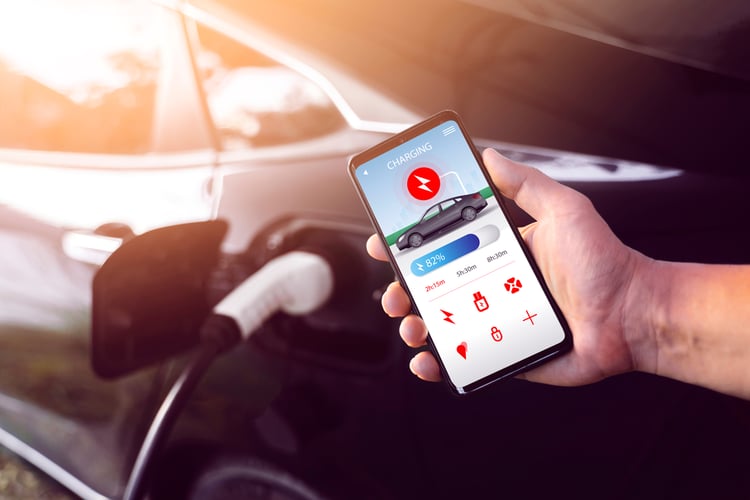
What is smart EV home charging and how does it work?
Electric vehicles (EVs) have never been more popular than today. Last year, electric car sales increased by 65 percent in Europe and more than doubled in the US compared to 2020. As the market matures, more drivers are discovering the benefits of electric mobility and the convenience of charging at home.
Our research shows that home charging is –by far– the most popular charging location, with 67 percent of current EV drivers charging at home. Unsurprisingly, optimizing energy usage is a key consideration when investing in a charging station, as 65 percent of EV drivers consider energy efficiency as the most important aspect when purchasing one.
Many homeowners are already using smart devices to optimize their homes, and EV chargers have a lot to offer in that regard as well. This is where smart charging stations come in.
Smart charging is an umbrella term surrounded by technical jargon and unfamiliar concepts that may sound complex and confusing. In this article, we explain what smart charging is and what homeowners should be aware of.
What is smart charging?
Smart or intelligent charging is a system in which an electric vehicle, the charging station, and a charging app communicate and share data. Compared to traditional EV chargers that aren’t connected to the internet, smart charging enables the user to remotely monitor, manage, and control the charging process and energy usage.
By automatically monitoring changes in load on the electrical circuit, smart charging helps optimize the use of the available energy and allows the charging station to operate in a cost-effective and energy-efficient manner.
-1.jpg?width=1000&name=shutterstock_1463745002%20(1)-1.jpg)
What makes an EV charger smart?
There are two key aspects that set a smart charger aside from a traditional, non-smart charger: hardware and software.
Smart charging hardware
While a smart charger still shares the same fundamental design as a regular EV charger, an essential distinguishing feature is the ability to connect to the internet to send and receive data. This requires a modem and a link to a network, which needs to be physically built into the charger. Some (often cheaper or smaller) chargers may not be equipped to establish a network connection and thus can’t leverage smart charging.
Smart charging software
Beyond hardware enabling connectivity, a smart charger also needs software to collect, aggregate, and make sense of usage data. EV drivers use a charging app to manage their charger. This way, the driver can control charging sessions remotely and get accurate energy-usage insights to help optimize performance and reduce costs.
.jpg?width=1000&name=shutterstock_1683775669%20(1).jpg)
Why is smart charging beneficial?
Smart charging helps optimize the charging process and manages the charging loads safely. This is because a smart charger monitors your electrical consumption and intelligently adjusts charging based on the available energy. In layman’s terms, this ensures an EV never draws more power from the grid than is available, preventing overloads and ensuring optimal charging speeds.
Smart charging can additionally unlock insights about charging behavior and energy use, which can help shift charging demand to times when electricity prices are lower, and there is less strain on the grid (and your wallet).
How does smart charging work?
Fundamentally, smart charging enables two-way data flows and communication between an EV and a charger in a way that allows the user to remotely control the charging process. In practice, smart charging refers to a set of features, including dynamic load balancing, vehicle-to-grid (V2G), and hub/satellite configurations, each of which work differently.
What are the different smart charging solutions?
Smart charging is a term that refers to a set of different features. Below we’ve listed the available smart charging solutions for electric car charging stations.
What is dynamic load balancing?
Dynamic load balancing helps balance the energy usage on your electrical circuit by intelligently allocating capacity to appliances that need it the most. As such, it ensures the power drawn by an EV charger is reactive to changes in conditions at your location. For example, if you turn on a washing machine while charging your EV, dynamic load balancing can temporarily reduce the charging output to free up some electrical capacity for your wash.
-1.jpg?width=1000&name=shutterstock_675267964%20(2)-1.jpg)
EV charging is a power-intensive activity: a standard 3-pin charging cable can draw up to 2.3 kWh, while a dedicated EV charger can go upwards of 7.4 kWh or 11 kWh (by comparison, a washing machine uses between 1.3 kWh and 3 kWh). Thus, EV charging can quickly put an electrical circuit under strain, especially if other appliances, such as an oven or a dishwasher, are used at the same time.
Dynamic load balancing protects your home by monitoring power use and ensuring it never goes above a safe maximum. As energy use approaches maximum capacity, this technology will automatically reduce an EV charger’s power output or pause the session entirely until enough capacity becomes available.
What is vehicle to grid (V2G)?
Vehicle-to-grid (V2G) is a technology that allows two-way power delivery between an EV’s battery and the power grid. Compared to regular smart charging, which flows in one direction only from the grid to the car’s battery, V2G allows EVs to momentarily push back power into the grid to balance variations in energy supply and demand.
V2G’s two-way power flow makes it a valuable source of backup power in case of outages, bypassing the need for diesel generators. But V2G is also a key catalyst for renewable energy: excess energy production, for example from solar panels during a sunny day, can be stored in an EV’s battery and released later when renewable production doesn’t meet demand (such as during the night). While powerful on an individual basis, V2G can become truly game-changing when applied at the scale of an entire power grid.
At present, V2G is still an emerging technology that requires significant investment. As such, it is mainly restricted to businesses and utility companies that operate their own charging networks. However, the technology is expected to become widely available in the next few years.
.jpg?width=1000&name=shutterstock_1173127708%20(1).jpg)
Hub/satellite
Another commercial application of smart charging technology is for hub/satellite configurations, where multiple EV chargers (satellites) are connected to a single modem, which acts as a hub. While less applicable for homes with individual chargers, a hub/satellite configuration can be an interesting option for apartment buildings and multiplexes which share a power source for multiple chargers, helping streamline data flows and optimizing charger management.
.jpg?width=1000&name=shutterstock_553451416%20(1).jpg)
Smart charging is a new, unfamiliar topic for many, encompassing a range of different concepts. At its core, smart charging leverages technology to improve charging efficiency and optimize capacity use at a given location.
As EV adoption grows, smart charging will be a crucial asset for managing the increased energy demand, preventing the grid from overloading, and streamlining the charging process.
Related articles

Peak shaving and load shifting explained
As electric vehicle sales reach record numbers, more people are discovering electric mobility and the flexibility of...

The 5 top benefits of EV smart charging at home
As electric mobility establishes itself as a prominent part of societies around the world and electric vehicle (EV)...

Can you save money with a smart EV charging station?
With the world collectively switching to more sustainable modes of transport, electric vehicles (EVs) have emerged in...
.jpg?width=1000&name=shutterstock_1662237379%20(1).jpg)